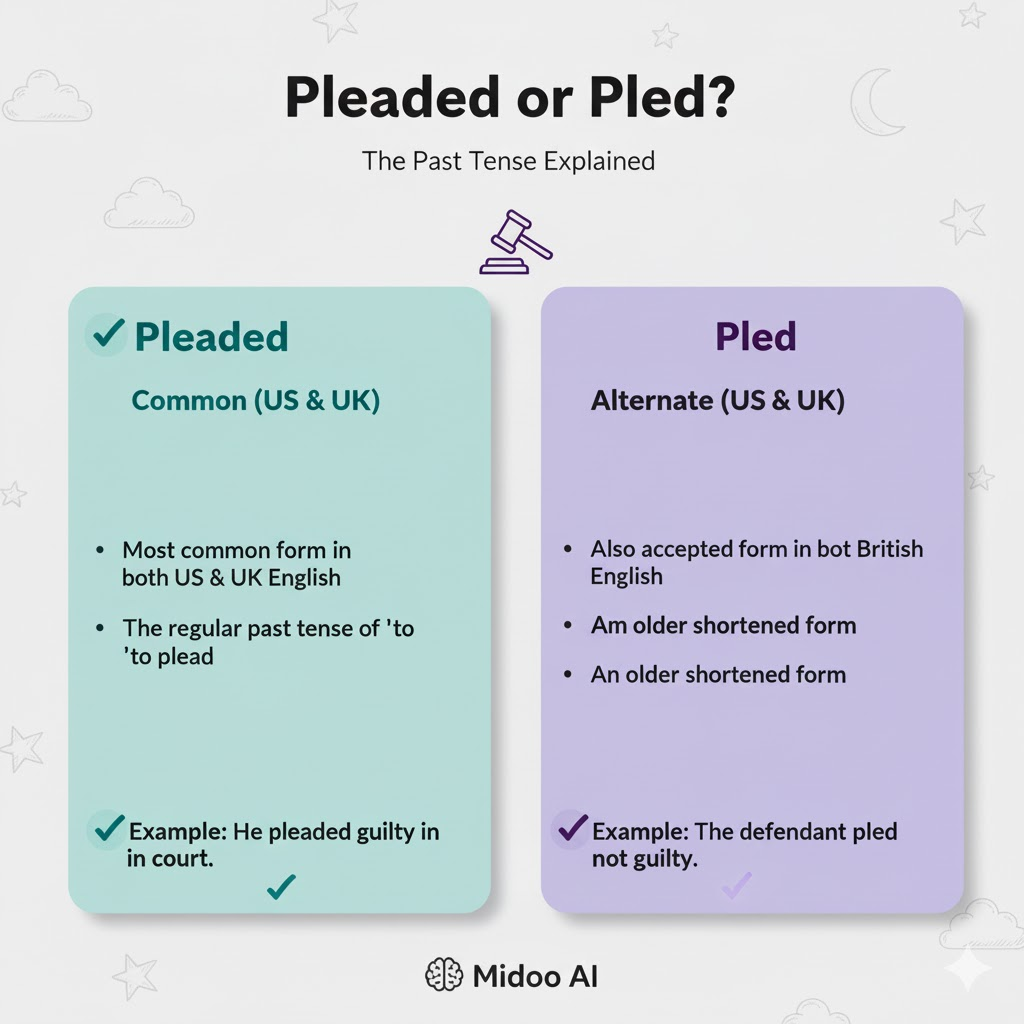Pleaded or Pled—Which Is Correct?

English verbs can be confusing, especially when there are two forms that look equally right—like pleaded and pled. You might have heard both in TV shows, court dramas, or even the news. But which one is actually correct?
At Midoo AI, we know that mastering small grammar details like this helps learners sound more fluent and confident. So today, let’s break down the difference between pleaded and pled, when to use each, and how to remember them easily.
1. The Core Difference
Both pleaded and pled are past tense forms of the verb plead, which means to make a serious request or to state something formally in court.
- Pleaded → The traditional and more common form, especially in formal English.
- Pled → A shorter, less formal alternative, used more often in American English and in legal contexts.
In short:
👉 Both are correct. The choice depends on where you are and how formal your writing is.
2. “Pleaded” in Standard English
Pleaded is the older and more widely accepted form across English-speaking countries. It’s used in both everyday language and legal writing.
Examples:
- She pleaded for forgiveness.
- The suspect pleaded not guilty in court.
- He pleaded with his boss for another chance.
Tip:
If you’re writing for an international or formal audience (like a newspaper or report), pleaded is always the safe choice.
3. “Pled” in American English
Pled is more common in American English, particularly in legal or spoken settings. It sounds shorter and a bit more direct.
Examples:
- The defendant pled guilty yesterday.
- He pled for mercy, but the judge refused.
- They pled not guilty during the hearing.
Tip:
If you’re writing a casual conversation or describing American courtroom scenes, pled sounds natural and authentic.
4. Regional Usage
Here’s a quick comparison of how both forms are used around the world:
| Region | Preferred Form | Example |
|---|---|---|
| United States | Pled (informal), Pleaded (formal) | The lawyer pled not guilty. |
| United Kingdom | Pleaded | She pleaded for help. |
| Canada | Pleaded (standard), Pled (less common) | He pleaded not guilty. |
| Australia | Pleaded | The witness pleaded with the court. |
Tip:
When in doubt, follow your region’s writing standard—or choose pleaded, which works everywhere.
5. Grammar Note: Regular vs. Irregular
“Plead” is technically a regular verb, which means the correct past tense should end in -ed (→ pleaded).
However, over time, some speakers started shortening it to pled, similar to other irregular verbs like “read” (read) or “lead” (led).
That’s why both exist today.
Tip:
Think of pled as the “spoken shortcut” and pleaded as the “formal original.”
6. Common Mistakes to Avoid
❌ He plead guilty.
✅ He pleaded guilty. or He pled guilty.
❌ She has pleded with her parents.
✅ She has pleaded with her parents.
❌ They have plead not guilty.
✅ They have pleaded not guilty.
Tip:
Remember, plead changes form in the past tense—so no “plead” in past or perfect forms.
7. Easy Memory Trick
Here’s a quick way to remember the difference:
🧠 If you want to sound formal → use “pleaded.”
💬 If you’re writing dialogue or American legal language → use “pled.”
Or think of it this way:
“Pled” is short, like an American shortcut.
“Pleaded” is longer and more proper for global writing.
FAQ
Q1: Is “pled” grammatically correct?
Yes, it’s accepted in American English, especially in legal contexts. But in formal writing, “pleaded” is safer.
Q2: Which is used in British English?
British speakers almost always use “pleaded.” “Pled” is rare in the U.K.
Q3: Can I use both in one document?
Avoid mixing them. Pick one form and stay consistent throughout your text.
Q4: Why are both accepted?
Language evolves through usage. “Pled” became common through spoken English, while “pleaded” remained standard in writing.
Q5: What should learners focus on?
Start with pleaded, since it’s correct everywhere. Learn pled later if you want to sound more natural in American English.